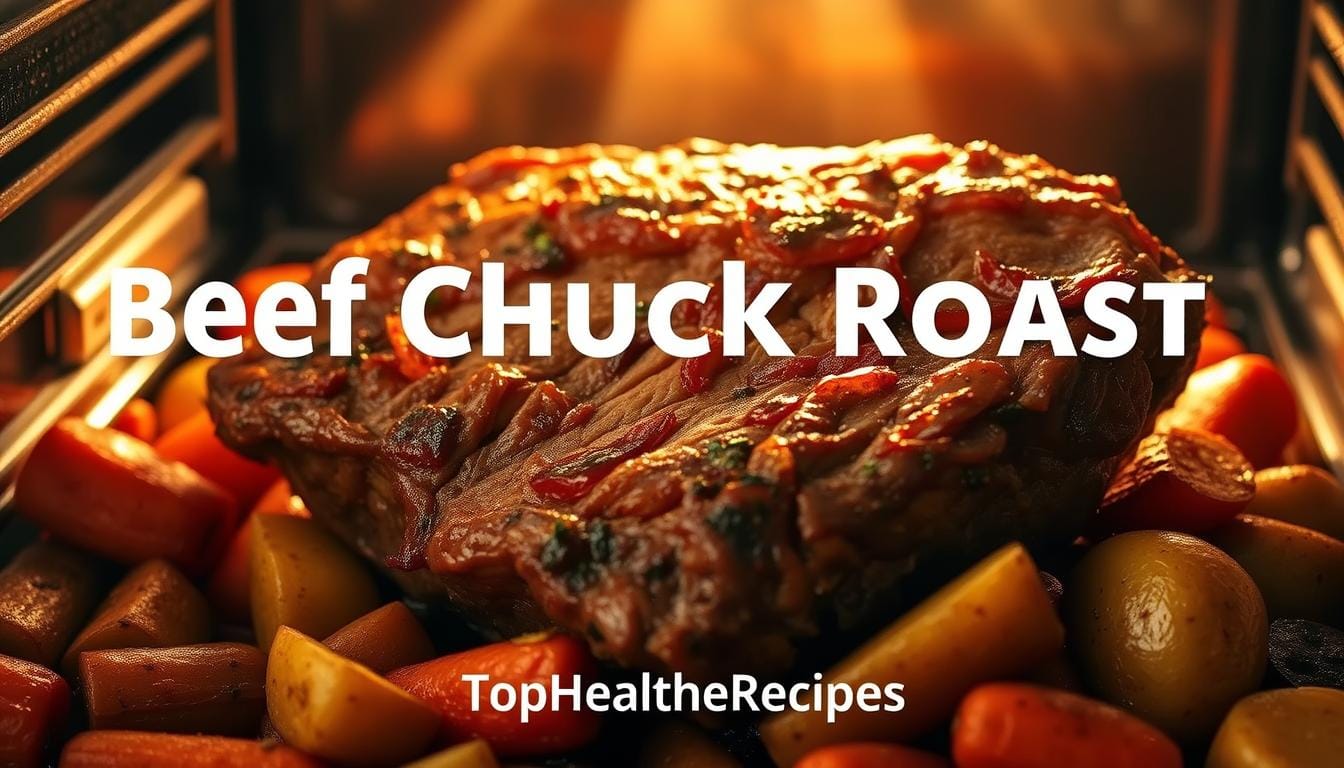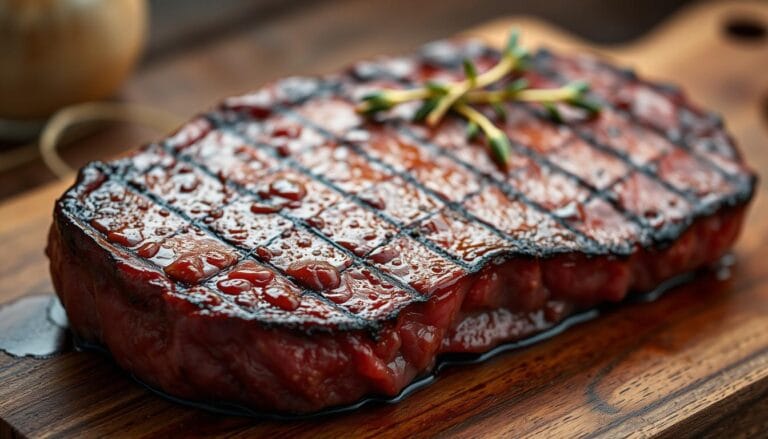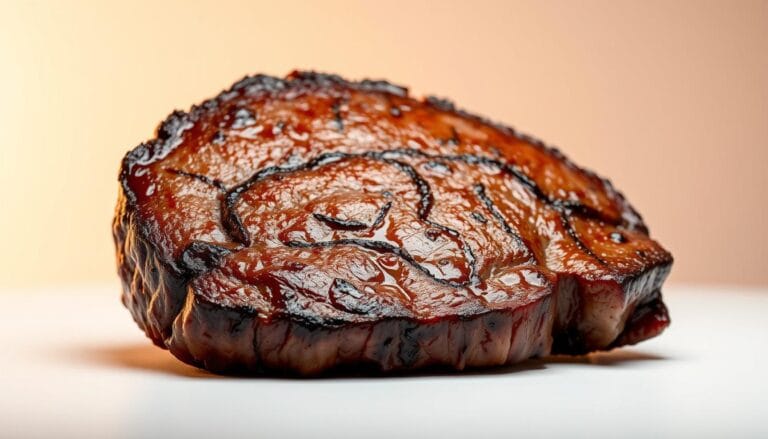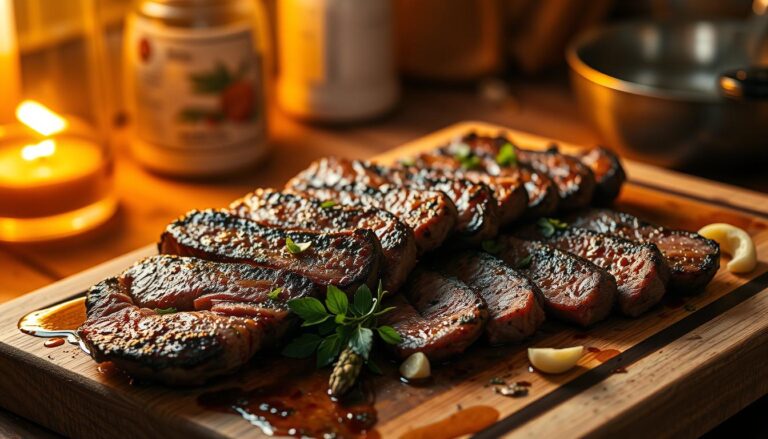Beef Chuck Roast Oven Recipe That’s Full of Flavor & Easy to Make
Table of Contents
Beef Chuck Roast Oven Recipe That’s Full of Flavor & Easy to Make
Imagine a cold winter evening with your home smelling like a classic comfort meal. Oven-roasted chuck roast brings back memories of family gatherings. The sizzle, rich flavors, and tender bites make it special.
Making a beef chuck roast in the oven is easy. With the right ingredients and techniques, you get a juicy, flavorful dish. It’s great for any occasion, whether you’re an experienced cook or just starting out.
Key Takeaways
- The beef chuck roast oven recipe is perfect for a flavorful and moist dish.
- Using the right spices and preparation techniques enhances the taste significantly.
- Oven roasted chuck roast can evoke fond family memories and comfort.
- This tender chuck roast recipe is easy enough for both beginners and experienced cooks.
- Perfect for creating hearty and satisfying meals.
Understanding Beef Chuck Roast
Learning about different beef cuts is key to making tasty meals. The beef chuck roast is a great choice for oven cooking. It’s both versatile and full of flavor.
What is Beef Chuck Roast?
Beef chuck roast comes from the cow’s shoulder. It’s known for its rich taste and lots of marbling. This makes it perfect for slow cooking.
When you cook it in the oven, the meat becomes tender and juicy. It’s great for hearty dishes like pot roast or slow-cooked stews.
Benefits of Choosing Chuck Roast
Choosing a chuck roast is a smart move because it’s affordable. It offers great value without sacrificing taste. Plus, it’s very versatile.
Its marbling adds a deep, beefy flavor. This makes it perfect for trying out new seasonings and spices. Knowing how to use a chuck roast can make your meals both comforting and fancy.
Preparing Your Beef Chuck Roast
To cook a delicious beef chuck roast in the oven, start with the right preparation. This means choosing the right cut and trimming it well. Let’s look at each step in detail.
Selecting the Right Cut
The secret to a tender beef chuck roast is picking the right cut. Look for one with good marbling. This means fat mixed into the meat, which adds flavor and keeps it moist.
A well-marbled roast has white streaks of fat, not big chunks on the surface. When picking a cut, consider its size too. A bigger roast takes longer but tastes better. A smaller one is quicker and perfect for small groups. Aim for a 3 to 5 pound roast for a family meal.
Trimming the Roast
While some fat is good, too much needs to be trimmed. You want to remove big fat pockets but keep a thin layer for tenderness. Here are some tips for trimming:
- Use a sharp knife to carefully slice away excess fat.
- Trim any silverskin, which is the tough, silver-colored membrane.
- Keep about 1/4 inch of fat on the top surface to help baste the meat as it cooks.
By following these tips, your beef chuck roast will be tender, flavorful, and perfectly textured. You’re on your way to a delicious meal.
Essential Ingredients for Roasting
The secret to a tasty beef chuck roast is in the spices and vegetables. A seasoned roast in the oven paired with roasted veggies makes a meal that wows everyone.
Spices and Seasonings
Choosing the right spices and seasonings is key for a flavorful beef chuck roast. Here are some must-haves:
- Salt and Pepper: A basic mix for seasoning any roast.
- Garlic Powder: Brings a savory depth to the beef.
- Onion Powder: Boosts the meat’s natural flavors.
- Rosemary: A fragrant herb that goes well with beef.
- Thyme: Adds a subtle earthy taste.
- Paprika: Adds a hint of spice and color.
Together, these seasonings make an aromatic crust that perfectly matches the chuck roast in the oven.
Vegetables to Include
No roast is complete without a mix of roasted vegetables. Here are some veggies to pair with your beef chuck roast:
- Carrots: Sweet and slightly caramelized when roasted.
- Potatoes: Absorb the roast’s flavors and offer a hearty side.
- Onions: Add a touch of sweetness and enhance the flavor.
- Celery: Provides a crunchy contrast to tender beef.
- Garlic Cloves: Mellows with roasting and adds a rich flavor.
- Parsnips: Brings an earthy and slightly sweet taste.
Putting these veggies in the roasting pan with the beef lets them soak up the juices and seasonings. This creates a meal that’s both harmonious and flavorful.
Prepping the Oven
Getting your oven ready is key to a perfectly roasted beef chuck. This step makes sure your roast cooks evenly. It keeps the flavor and tenderness in check. Knowing the right oven temperature for roasting and whether to use foil are important skills.
Ideal Temperature for Roasting
For the best roast, aim for an oven temperature between 275°F and 325°F. This slow cooking breaks down tough fibers, making the meat tender. Keeping the oven temperature for roasting steady is vital to avoid dry or overcooked meat.
Foil vs. No Foil: What to Choose
Choosing to use aluminum foil or not can change your roast’s outcome. Foil keeps the meat moist, making it juicier and tender. But, not using foil lets you get a crispy crust that many love for its taste and texture. Your choice depends on whether you want a moist roast or a crispy crust.
The Perfect Cooking Method
Finding the right way to cook a beef chuck roast can make a big difference. By using certain techniques, you can make sure your roast is full of flavor, tender, and juicy.
Searing Before Roasting
Searing beef chuck roast is a key step before slow roasting it in the oven. Searing creates a caramelized crust on the outside. This crust keeps the flavors and juices inside, preventing them from escaping during slow roasting.
To sear beef chuck roast, heat a heavy skillet over medium-high heat. Add a small amount of oil, then brown the roast on all sides until it’s golden.
Slow Roasting Techniques
Slow roasting beef in the oven means cooking it at low temperatures for a long time. This method breaks down the connective tissues in the roast. As a result, the roast becomes tender and succulent.
The ideal temperatures for slow roasting are between 275°F and 325°F. Roasting times vary based on the size of the roast. This method ensures the meat is tender and evenly cooked.
Preheat your oven to the desired temperature.
Place the seared beef chuck roast in a roasting pan.
Cover the pan with a lid or foil.
Cook for several hours until the meat reaches the desired doneness.
By combining cooking methods like searing and slow roasting, you can get a perfectly cooked beef chuck roast. It will be both flavorful and tender.
Cooking Time Guidelines
Cooking a beef chuck roast to perfection needs careful attention. This includes knowing the right cook time and temperature. The beef chuck roast oven times change based on the roast’s size and the oven type.
For the best results, consider several key factors. These can affect the cook time for roast.
Factors Influencing Cook Time
The roast’s size, the oven’s performance, and how tender you want the meat are important. Usually, a chuck roast cooks for 2 to 3 hours at 350°F. But, this can change. Cooking at a lower temperature for longer makes the meat tender and flavorful.
- Size of the Roast: Bigger roasts take longer, about 45 minutes per pound.
- Oven Performance: A consistent and accurate temperature is key for good results.
- Desired Doneness: Adjust the cooking time to get your preferred doneness.
Using a Meat Thermometer
The best way to ensure your chuck roast is cooked right is with a meat thermometer. It helps check the doneness and prevent overcooking.
- Put the thermometer into the thickest part of the roast.
- For a medium-rare roast, the internal temperature should be 135°F. A medium roast should reach 145°F.
- Let the roast rest before carving to let the juices spread out.
Flavoring Your Roast
To make a savory and tender beef chuck roast, you need to flavor it right. This involves marinating and making a flavorful rub. These steps add rich flavors and tenderize the meat for a great meal.
Marinating Tips
Choosing the right marinade is key for marinating beef chuck roast. Pick a mix that goes well with the beef’s taste. Olive oil, garlic, soy sauce, Worcestershire sauce, and fresh herbs are great choices.
- Timing: Marinate the roast for at least 4 to 6 hours, or overnight for a deeper flavor penetration.
- Container: Use a ziplock bag or a shallow dish to ensure the marinade coats the entire roast evenly.
- Refrigeration: Always marinate beef in the refrigerator to prevent bacterial growth.
Follow these tips to make your marinated beef chuck roast full of flavor and tender.
Creating a Flavorful Rub
Making a rub for your beef can take its taste to the next level. A good rub brings out the meat’s natural flavors and adds a tasty crust.
- Core Ingredients: Mix salt, black pepper, paprika, garlic powder, onion powder, and brown sugar for a basic rub.
- Extra Flavor: Add dried herbs like thyme, rosemary, or oregano for a fragrant touch.
- Application: Coat the roast well with the rub, pressing it in to make it stick.
Using a flavorful rub not only seasons the roast but also gives it a crispy outside.
Adding Side Dishes
Make your beef roast dinner even better with the right side dishes. Choose vegetables and starches that match the roast’s flavors. This will make your meal unforgettable and delicious.
Best Vegetables to Roast Together
- Carrots
- Parsnips
- Brussels Sprouts
- Broccoli
- Cauliflower
- Sweet Potatoes
Roasting these vegetables brings out their natural sweetness. They also soak up the beef roast’s juices, adding flavor.
Complementary Starches
Adding starches to your roast dinner is a great idea. Here are some options:
- Mashed Potatoes
- Buttered Rice
- Herbed Couscous
- Crusty Bread
- Polenta
These side dishes offer different textures and tastes. Mashed potatoes are creamy, while crusty bread is perfect for soaking up gravy.
Serving Suggestions
Presenting your beef chuck roast can make your meal unforgettable. Here are some tips to serve beef chuck roast beautifully and carve it with skill.
Slice it Right: Carving Techniques
Carving techniques are key for tenderness and flavor. Let the roast rest for 15-20 minutes to redistribute juices. Use a sharp knife to slice against the grain for tender bites.
Place the beef on a cutting board and hold it steady with one hand. Slice evenly for a polished look. This improves taste and presentation.
Plating for Presentation
Good plating makes your dish look appealing and tempting. Here are some dinner presentation tips:
- Arrange sliced beef in a fan shape on the plate or platter.
- Put roasted vegetables around the meat for color balance.
- Add fresh herbs like parsley or thyme for greenery and aroma.
Use a large, white platter to highlight your roast and vegetables. The platter and arrangement greatly impact your dinner’s appeal.
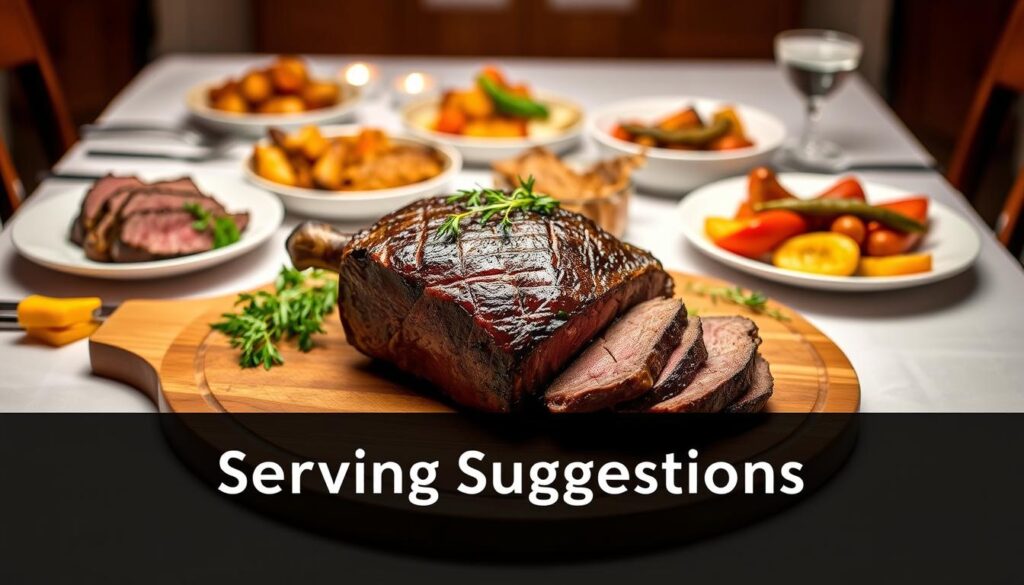
Follow these tips to impress your guests with both flavor and presentation of your beef chuck roast.
Storing Leftovers
Getting the most out of your beef chuck roast means storing it right and finding new uses for leftovers. Keeping your roast safe to eat is key to enjoying tasty meals later on.
Proper Cooling and Storage Tips
It’s important to cool your beef chuck roast fast to keep it safe. Let it cool to room temperature, but not for more than two hours. After cooling, put it in an airtight container or wrap it well with foil or plastic. Keep it in the fridge for up to three days or freeze for up to three months.
Creative Ways to Use Leftovers
There are many ways to turn your beef chuck roast into new dishes. Here are a few ideas:
- Sandwiches: Slice the roast thinly and use it as a filling for sandwiches, adding your favorite toppings and condiments.
- Soups: Dice the leftover roast and add it to a hearty vegetable soup for an added burst of flavor.
- Salads: Shred the roast and toss it into a fresh salad with greens, nuts, and a light vinaigrette.
- Tacos: Season the shredded roast with taco spices and serve it in warm tortillas with your choice of toppings.
By following these tips and ideas, you can store your beef chuck roast correctly. You’ll also have fun ways to enjoy your leftovers, making your meals exciting and tasty.
Common Mistakes to Avoid
Cooking a beef chuck roast can be tricky. It’s easy to make cooking mistakes that can ruin the texture and taste. Two big mistakes are overcooking the beef and not seasoning it enough.
Overcooking Your Roast
An overcooked beef chuck roast turns tough and dry. This happens when it’s cooked too long or at the wrong temperature. To fix this, keep an eye on your roast and use a meat thermometer. This ensures it’s cooked just right without getting overdone.
Skipping Seasoning
Seasoning your roast beef is key. It brings out the meat’s natural flavors, making your dish taste better. Don’t forget to add herbs, spices, and marinades. A well-seasoned roast will have a burst of flavor in every bite, avoiding a bland taste.
| Common Cooking Mistakes | Impact | Solution |
|---|---|---|
| Overcooking Beef | Tough and dry meat | Use a meat thermometer |
| Skipping Seasoning | Bland flavor | Apply ample herbs and spices |
By watching out for seasoning roast beef and avoiding common mistakes, you can make your dish juicy, flavorful, and perfectly cooked.
Frequently Asked Questions
Many home cooks wonder about chuck roast cooking questions. They ask about roast doneness and if they can cook it from frozen. Knowing the answers will help you make the perfect roast every time.
How to Tell When It’s Done?
Figuring out when a roast is done is key for great taste and texture. A meat thermometer is your go-to tool. Here’s a quick guide to internal temperatures:
- Medium-Rare: 145°F
- Medium: 160°F
- Well-Done: 170°F
Stick the thermometer into the thickest part of the roast for an accurate reading. Let the roast rest after cooking. This lets the juices spread out evenly.
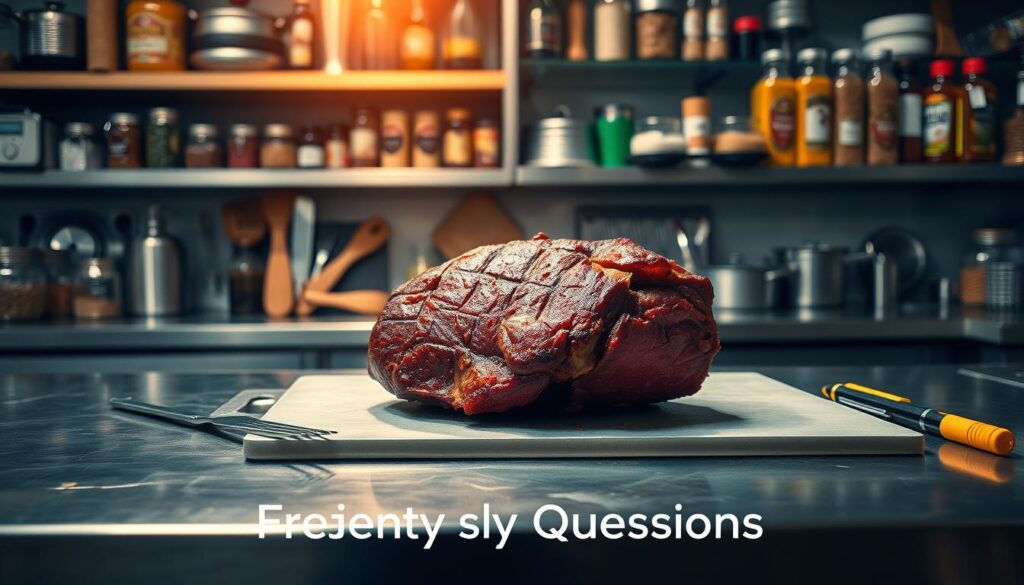
Can You Cook from Frozen?
Many wonder if you can cook a chuck roast from frozen. The answer is yes, but you’ll need to adjust cooking time and method. Cooking a frozen roast takes about 50% longer than a thawed one.
It’s best to use a slow cooker or oven for even cooking. This ensures your roast turns out perfectly.
Pairing Wine with Beef Chuck Roast
Choosing the right wine for beef is key to a great meal. Beef chuck roast has deep flavors that match well with full-bodied red wines. These wines stand up to the meat’s strong taste. Here are some top picks that go great with beef chuck roast:
Best Wine Choices
- Cabernet Sauvignon: This classic wine has bold tannins and dark fruit flavors, making it a top choice for roast beef.
- Syrah/Shiraz: Known for its spicy notes and rich texture, Syrah pairs beautifully with the hearty flavors of beef chuck roast.
- Merlot: With its smooth, plummy character, Merlot provides a delightful contrast to the meat’s savory taste.
- Zinfandel: This wine adds a touch of sweetness with its berry profile, balancing the robustness of the roast.
Serving Temperature for Wine
The right serving temperature brings out the best in the wine and complements the dish. Here are some tips for serving wine with your beef chuck roast dinner:
- Cabernet Sauvignon: Serve at 60-65°F to preserve its rich flavors and tannins.
- Syrah/Shiraz: A temperature of 60-64°F brings out the wine’s spicy notes.
- Merlot: Ideal at 60-65°F to enhance its smooth texture.
- Zinfandel: Best enjoyed at 60-65°F, balancing its sweet and fruity profile.
These tips ensure each bottle of wine complements the dish, making for an unforgettable meal. Finding the best wines for roast beef and serving them at the right temperature can take your meal to new heights.
The Importance of Resting
Resting beef after roasting is key to making your beef chuck roast tender and flavorful. It lets the juices spread out evenly, making the roast taste better and stay moist.
Why Let it Rest?
Letting the meat rest helps the juices spread back through the meat. This keeps the roast juicy when you carve it. Without resting, the roast might end up dry and less tasty.
How Long to Rest Your Roast
The rest time for your roast depends on its size and cut. Generally, rest it for 15 to 20 minutes. This lets the meat’s temperature even out and the juices fully mix in, making each bite juicy and flavorful.
Making Gravy from Pan Drippings
Making a tasty gravy from your roast’s pan drippings is easy and makes your dish better. You just need a few ingredients and steps to turn those drippings into a smooth, flavorful gravy. This recipe will show you how to make it and adjust it to your liking.
Simple Gravy Recipe
Begin by straining the pan drippings to get rid of solids. Put the drippings in a saucepan and heat them over medium heat. Whisk in flour slowly to avoid lumps.
Then, add beef broth little by little while whisking. Keep going until the gravy is as thick as you like. Simmer it until it’s smooth and rich. Season with salt and pepper to taste. This way, your gravy will bring out the best flavors of the roast.
Adjusting Thickness and Flavor
To get the right thickness, have beef broth or water and cornstarch ready. If it’s too thick, add a bit of broth or water. For thicker gravy, mix a teaspoon of cornstarch with cold water and add it slowly, stirring constantly.
To make it taste better, try adding Worcestershire sauce, thyme, or garlic powder. These small changes can make your gravy perfect for your beef dish.
FAQ
How to Tell When It’s Done?
Can You Cook from Frozen?
What is Beef Chuck Roast?
Benefits of Choosing Chuck Roast?
How to Select the Right Cut?
Ideal Temperature for Roasting?
Searing Before Roasting?
Using a Meat Thermometer?
Marinating Tips?
Best Vegetables to Roast Together?
Slice it Right: Carving Techniques?
Proper Cooling and Storage Tips?
Making Gravy from Pan Drippings?
Why Let it Rest?
Common Mistakes: Overcooking Your Roast?
Common Mistakes: Skipping Seasoning?
For more cooking tips, stay connected with us. We also recommend the cookbook Skinnytaste Simple: Easy, Healthy Recipes with 7 Ingredients or Fewer
For more Recipes about Beef?
Did You try our recipe ?
There are no reviews yet. Be the first one to write one.
